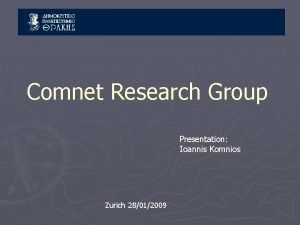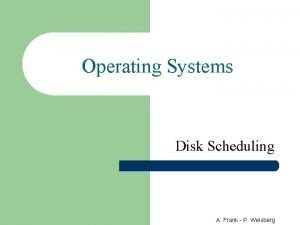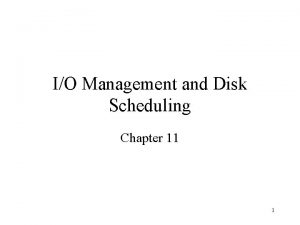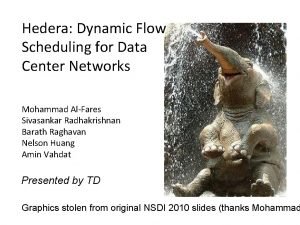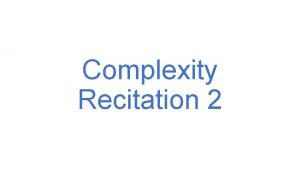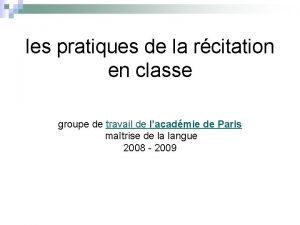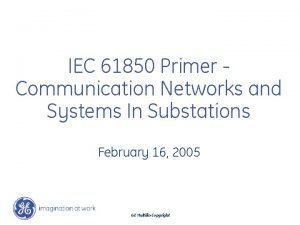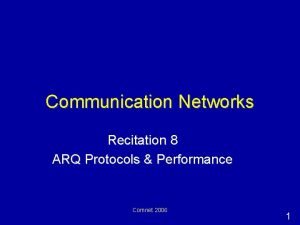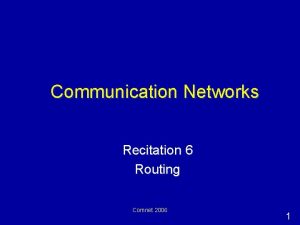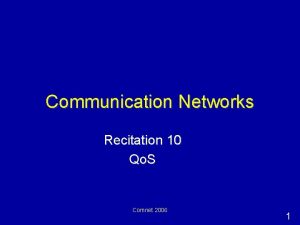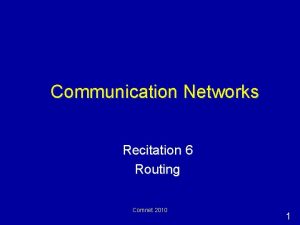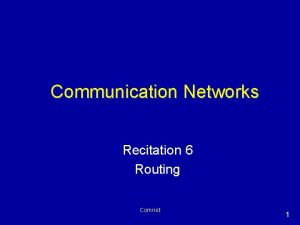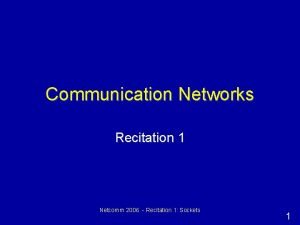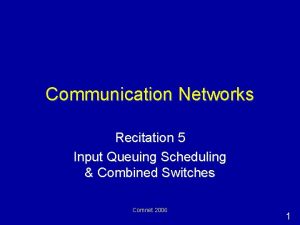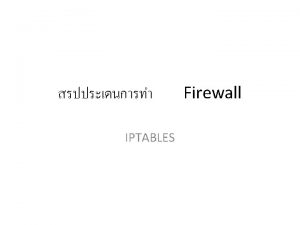Communication Networks Recitation 4 Scheduling Drop Policies Comnet
















- Slides: 16

Communication Networks Recitation 4 Scheduling & Drop Policies Comnet 2006 1

Queueing Basics • A queue consists of a scheduling discipline and a drop policy input drop policy: what is dropped upon overflow queued packets Comnet 2006 scheduling discipline: what packet gets sent next 2

Generalized Processor Sharing • The ideal max-min fair scheduling scheme – Visit each non-empty queue in turn – Serve infinitesimal from each – GPS is not implementable; we can serve only packets Comnet 2006 3

Weighted Fair Queueing Problem: We need to serve a whole packet at a time. Solution: 1. Determine what time a packet, p, would complete if we served flows by GPS. Call this the packet’s finish time, F(p). 2. Serve packets in the order of increasing finish time. Comnet 2006 4

WFQ Round -- Virtual Time • Round number is a real-valued variable that increases at a rate inversely proportional to the number/weight of active connections • Updating the number of connections: – A connection becomes active when a packet arrives to an empty queue – A connection becomes inactive when R(t) > F(p), where p is the last packet served Comnet 2006 5

Virtual time Example 1 1/3 1/2 1/3 A F 1=1 B F 1=2 L=2 C F 1=2 L=1 F 2=3. 5 L=2 Comnet 2006 6

Understanding bit by bit WFQ 4 queues, sharing 4 bits/sec of bandwidth 6 2 5 1 4 0 3 Time A 1 = 4 1 B 1 = 3 C 2 = 1 C 1 = 1 D 2 = 2 D 1 = 1 1 Weights : 1: 1 6 2 5 1 A 2 = 2 4 0 3 A 2, C 3 arrive A 1 = 4 1 B 1 = 3 C 3 = 2 C 2 = 1 C 1 = 1 D 2 = 2 6 2 Weights : 1: 1 A 2 = 2 5 1 D 1, C 1 Depart at R=1 Time D 1 = 1 4 0 A 1 = 4 B 1 = 3 3 C 3 = 2 C 2 = 1 C 1 = 1 D 2 = 2 D 1 = 1 D 1 1 1 C 1 B 1 A 1 Round 1 1 Time C 2 Departs at R=2 1 1 1 D 2 C 2 B 1 Round 2 1 A 1 D 1 C 1 B 1 A 1 Round 1 Weights : 1: 1 Comnet 2006 7

Understanding bit by bit WFQ 6 2 5 1 A 2 = 2 4 queues, sharing 4 bits/sec of bandwidth 4 0 3 A 1 = 4 B 1 = 3 C 3 = 2 C 2 = 1 C 1 = 1 D 2 = 2 6 2 Weights : 1: 1 5 4 1 0 A 2 = 2 D 1 = 1 B 1 = 3 C 2 = 1 C 1 = 1 D 2 = 2 D 1 = 1 D 2, 1 D 2 1 B 1 C 3 Depart at R=3 B 1 A 1 5 1 A 2 = 2 4 0 A 1 D 1 C 1 B 1 A 1 Round 1 1 Time 1 1 1 A 2 C 3, A 1 Depart at R=4 Departs at R=6 A 2 6 5 C 3 A 1 D 2 Round 4 C 3 B 1 A 1 D 2 Round 3 C 2 B 1 A 1 D 1 Round 2 C 1 B 1 A 1 Round 1 1 3 Time 1 B 1 = 3 C 2 = 1 C 1 = 1 D 2 = 2 B 1 Sort packets A 1 = 4 C 3 = 2 C 2 Round 2 Weights : 1: 1 6 2 D 2 Round 3 1 3 A 1 = 4 C 3 = 2 Time D 1 = 1 1 Departure order for packet by packet WFQ: Sort by finish round of packets A 2 C 3 A 1 A 1 D 2 B 1 B 1 C 2 D 1 C 1 1 1 Weights : 1: 1 Comnet 2006 8

WF²Q • Packet approximation algorithm of GPS. • Choosing the packet with the smallest finish time among all the packets that have already started service in the corresponding GPS emulation. • Almost identical to that of GPS, differing by no more than one maximum size packet. Comnet 2006 9

Comnet 2006 10

Drop-tail • Signals congestion only when the queue is already saturated • Likely to drop more packets from the same flow • Unfair with bursty flows Comnet 2006 11

Random Early Detection (RED) Comnet 2006 12

Comnet 2006 14

The Advantages of RED • No bias against bursty traffic • No global synchronization • Packet marking probability proportional to connection’s share of bandwidth • Scalable: no per-connection state Comnet 2006 15

Explicit Congestion Notification (ECN) Packet Drops 7 6 5 4 3 2 1 Sender Receiver 1 ECN 2 7 4 6 5 5 4 6 3 7 2 1 Sender Receiver 1 2 3 Comnet 4 2006 5 6 7 16

ECN Details • Packets have a special Early Congestion Notification (ECN) bit • The ECN bit is set to 1 • Receivers forward ECN bit state back to sender in acknowledgments • Sender can adjust rate accordingly Comnet 2006 17
 28012009
28012009 Disk scheduling in operating system
Disk scheduling in operating system Disk scheduling policies
Disk scheduling policies Job scheduling vs process scheduling
Job scheduling vs process scheduling Hedera: dynamic flow scheduling for data center networks
Hedera: dynamic flow scheduling for data center networks Passive recitation
Passive recitation Namaz posture 1
Namaz posture 1 Is the rote recitation of a memorized written message
Is the rote recitation of a memorized written message Poem recitation objectives
Poem recitation objectives Know your material
Know your material What is meant by etiquette of recitation of the holy quran
What is meant by etiquette of recitation of the holy quran Recitation les machines
Recitation les machines Process oriented rubric example
Process oriented rubric example Récitation les hiboux
Récitation les hiboux Difference between datagram and virtual circuit switching
Difference between datagram and virtual circuit switching Basestore iptv
Basestore iptv Iec 61850 communication networks and systems in substations
Iec 61850 communication networks and systems in substations
